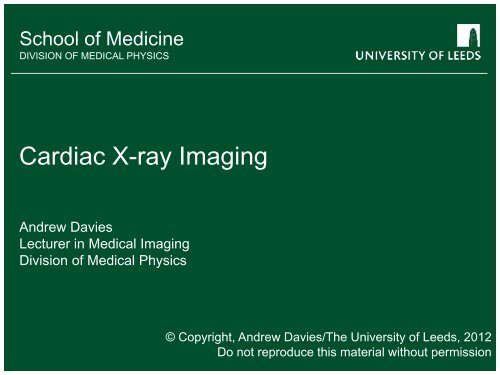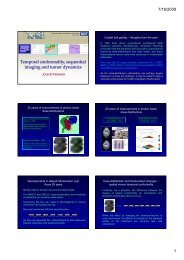Physics of Fluoroscopy
Physics of Fluoroscopy
Physics of Fluoroscopy
- No tags were found...
You also want an ePaper? Increase the reach of your titles
YUMPU automatically turns print PDFs into web optimized ePapers that Google loves.
School <strong>of</strong> MedicineDIVISION OF MEDICAL PHYSICSCardiac X-ray ImagingAndrew DaviesLecturer in Medical ImagingDivision <strong>of</strong> Medical <strong>Physics</strong>© Copyright, Andrew Davies/The University <strong>of</strong> Leeds, 2012Do not reproduce this material without permission
Contents1. X-ray imaging fundamentals2. X-rays cardiac imaging and the cardiaccatheterisation laboratory3. Characteristics <strong>of</strong> cardiac X-ray images4. Example image sequences5. X-ray dose6. Summary7. Bibliography
Why image with X-rays?X-ray imaging can be used to detect s<strong>of</strong>t tissue abnormalities,image bone, and with the use <strong>of</strong> contrast agents image thecadiovascular, GI and other internal structures.It can also be used to visualise devices within the body asthey are manipulated during interventions.In cardiac imaging X-ray imaging plays a key role in both thediagnosis and treatment <strong>of</strong> coronary heart disease, andother cardiac conditions.
X-RAY PRODUCTION
Producing X-raysX-rays are produced by colliding electrons into a metal targetin an evacuated X-ray tube.Electrons are produced by passing a current through afilament, heating the filament, resulting in electron emission.The electrons are accelerated towards a metal target anodeby the application <strong>of</strong> a potential difference typically 40 – 120kV for cardiac imaging.Anode+ -e -X-ray photonsCathodeFilament coil& focussing cup
Producing X-raysInteraction between the electronsand the target produce X-rays asBremsstrahlung andcharacteristic radiation.Tungsten anodeX-ray tube output with3.5 mm Al inherent filtration50 kV p12 x 104 Energy (keV)A polyenergetic radiation beam isproduced.An X-ray generator isresponsible for producing theelectrical supply to the X-raytube.X-ray production is veryinefficient (0.9 x 10 -9 ZV).N photons per mm 2 per mAs10864270 kV p90 kV p00 10 20 30 40 50 60 70 80 90 100
X-RAY INTERACTIONS
X-ray interactions with matter1. Photoelectric AbsorptionAn X-ray photon interacts with aninner electron <strong>of</strong> an atom,transferring all <strong>of</strong> its energy to theelectron.The electron is ejected from theatom and the electron hole is normallyfilled by a series <strong>of</strong> electron cascadesfrom outer shell electrons, resulting inauger electron and characteristicphoton emissions. The X-ray photonis effectively removed from thebeam.Chance <strong>of</strong> photoelectric absorptionproportional to (Z/E p ) 3 .Ejected electronIncident X-ray photonCharacteristic X-rayand/orAuger electron
X-ray interactions with matter2. Compton (Incoherent) ScatterAn X-ray photon interacts with aloosely bound or free electron,transferring part <strong>of</strong> its energy to theelectron.The X-ray photon is deflected, butis not removed from the beam.Scattered X-ray photons can:• further interact with the patient, or• escape the patient and interact withother objects such as the X-ray imagereceptor (degrading image quality) ormembers <strong>of</strong> staff.Incident X-ray photonEjectedelectron
IMAGE FORMATION
Image formationModern X-rayimage receptorsare highly efficientsolid state (“flatpanel”) devices.X-raysPolished Al coatingintensityCsI scintillatorconverts x-rayphotons to lightdistancea-Si TFT photodiode array
Projection imagesX-ray images are radiographic shadowgrams- three dimensional objects areprojected onto a two dimensional image.
X-RAY CARDIAC IMAGING ANDTHE CATH LAB
The cath lab
The X-ray cath Lab
Coronary X-ray image sequencesFeature Typical OptionalTemporal resolutionSpatial resolutionImaging modeField <strong>of</strong> viewC-arm motion15 x 5 ms pulses persecond1024 x 1024 pixels20 x 20 cm receptor area(200 µm pixel pitch;100 µm effective pixelsize in object plane)30 fps also commonclinically, but both higherand lower frame ratespossibleSpecialist imagereceptors can havesmaller pixel pitch<strong>Fluoroscopy</strong> & acquisition User selectable25, 20 & 15 cm±45° C-C, ±120° Lat18° - 25°/s motorisedmotion
EXAMPLE IMAGES
Percutaneous Coronary InterventionBlood has a very similar linear attenuationco-efficient to s<strong>of</strong>t tissue, and therefore isvery difficult to directly discriminate using X-ray imaging.Blood is therefore temporarily replaced byan iodinated contrast medium with a muchgreater attenuation than blood for imaging.A catheter is inserted into radial or femoralartery and advanced over the aortic arch tothe aortic root. It is then selectively engagedwith the ostium <strong>of</strong> the right or left coronaryartery, allowing the injection <strong>of</strong> contrastmedium or placement <strong>of</strong> interventionaldevices into the artery.
StentingA stent is a metal mesh support structure placed in the arteryto reduce the rate <strong>of</strong> restenosis.The stent is positioned underfluoroscopic guidance…… and inflated to expand thestent. The balloon is thenwithdrawn.
Post intervention angioPost intervention angiogramsare then acquired in order toconfirm proper deployment,and restoration <strong>of</strong> vessellumen.More than one stent can beplaced in the same artery, orfurther arteries treated asnecessary.
<strong>Fluoroscopy</strong> (EP)
3D imaging in the cath lab1221
3D model
Radiation DoseDose rates on the image receptor dictate the level <strong>of</strong> noisewithin the image (noise ∝ √dose).X-rays have two main detrimental effects to humans:• Deterministic effects, mainly damage to the skin• Threshold (2 Gy) before any effect seen• Severity increases with dose• Stochastic effects, fatal cancer and birth defects• Severity not affected by dose• Likelihood <strong>of</strong> occurrence is related to dose
Radiographic imaging <strong>of</strong> the heartFeatureHigh temporal and spatialresolution possibleProjection geometryAnatomy: accurateassessment <strong>of</strong> morphologyFunction: assessment <strong>of</strong>blood flow / perfusionNotesLimited in humans to acceptable patient radiationdose levelsProjection information does not resolve 3Dinformation directly, but requires less X-ray dosethan cardiac CT.Aterial, veneous and ventrical lumen all possible.Morphological information <strong>of</strong> vessel lumen stenoticseverity does not necessarily correlate withfunctional severity.Blood flow is normally measured via anotherdevice (e.g. intra-arterial doppler). Has beendemonstrated directly from imaging, but is notroutine (or straightforward). Assessment <strong>of</strong>perfusion currently rudimentary, but remains anarea <strong>of</strong> active research.
Perfusion assessmentPre interventionPost intervention
BibliographyRadiological <strong>Physics</strong>• Bushberg JT, Siebert JA, Leidholdt E, Boone JA. 2012. The Essential<strong>Physics</strong> <strong>of</strong> Medical Imaging. 3 rd Edition. Lippincott Williams & Wilkins.• Huda W. 2009. Review <strong>of</strong> Radiological <strong>Physics</strong>. 3 rd Edition. LippincottWilliams and Wilkins.Clinical Applications• Lanzer P (Ed.) 2012. Catheter Based Cardiovascular Interventions: aKnowledge based approach. 2012 Edition. Springer.Questions• a.g.davies@leeds.ac.uk





